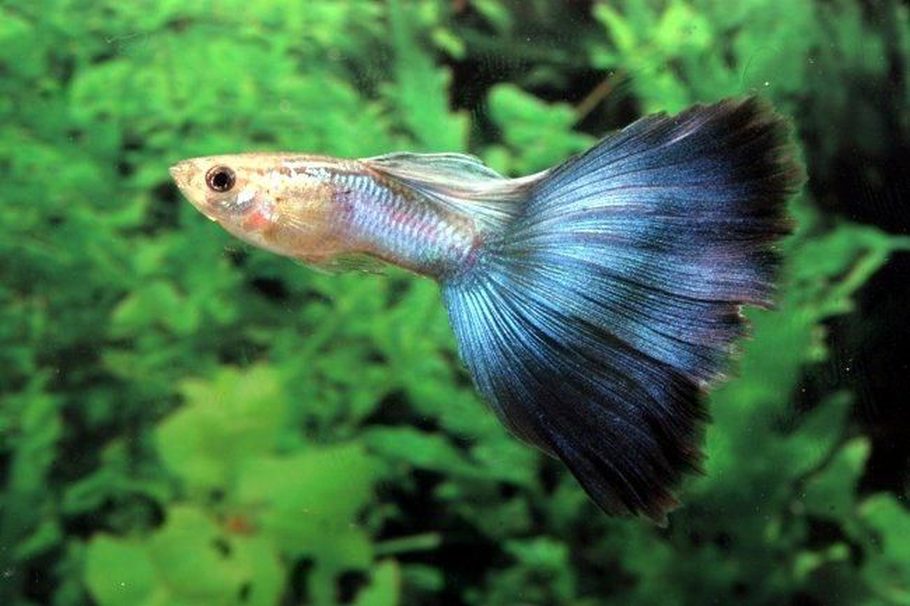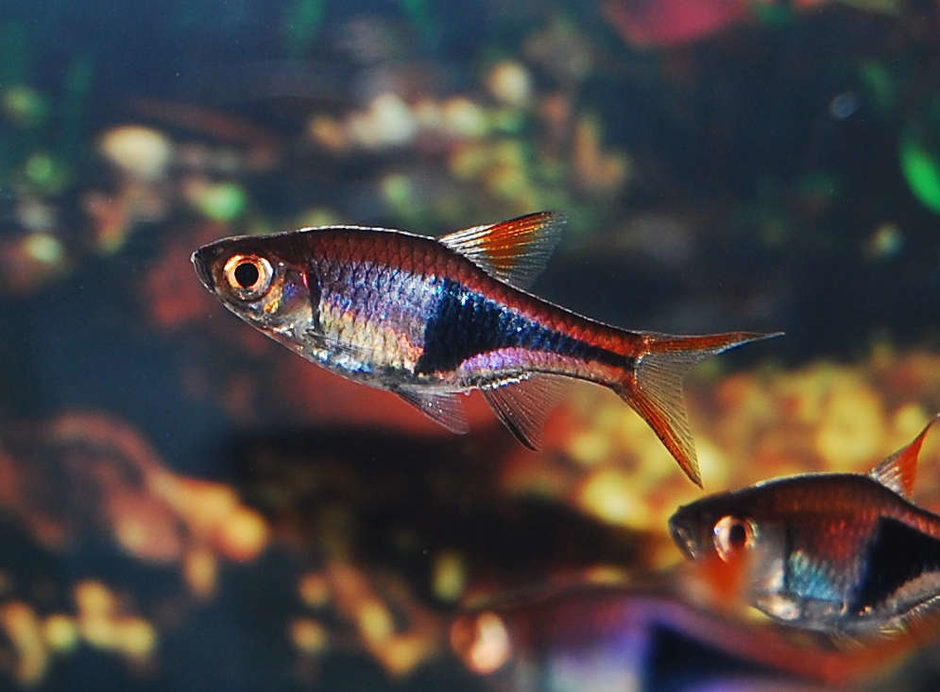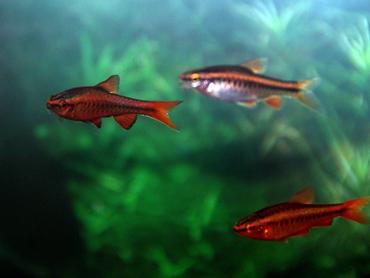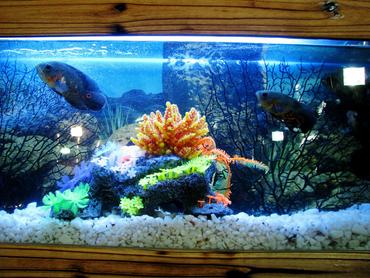SHOW TANK-WORTHY TANKMATES FOR FANCY GUPPIES

Updated
Everyone knows that guppies are some of the most colorful freshwater fish while also being some of the easiest to care for. But what other colorful fish can you keep in a show tank with guppies? Keep reading to find out.
The fancy guppy is a popular beginner fish because they are small, hardy, and easy to care for. More than that, however, they exhibit bright colors, long fins, and unique patterns. Not only are fancy guppies a beautiful species to cultivate, but they are different from most brightly colored species in that they are very peaceful – they make great additions to the community tank.
When cultivating a guppy tank, you should think carefully when selecting your tankmates. Not only should you think about compatibility in terms of temperament, but you also want to choose species that will enhance rather than detract from the beautiful colors seen in your guppies. Keep reading to learn about the top tankmates for a show tank of fancy guppies.

Ten Colorful Tank Mates for Guppies
Most small to medium-sized community fish would make a compatible tankmate for guppies, but if you want to create a show-stopping tank you need to choose your fish carefully. For a colorful show tank, consider the following ten tankmates for your guppies:
Rummynose Tetra – These fish are named for their bright red noses. Rummynose tetras grow up to 2 inches in length and their silver coloration will help your guppies to stand out. These fish are generally very peaceful and they do well in community tanks, particularly when kept with six or more of their own species.
Female Betta – Though male betta fish should not be kept with other fish, females are much less aggressive. Don’t be turned off by the dull female bettas you see in the pet store – if you purchase them online or from a breeder, you can find female bettas that are actually quite colorful. Just keep in mind that bettas are carnivorous – if your betta gets too big it might start targeting smaller guppies as prey.
Cardinal Tetra – One of the most recognizable species of freshwater fish, cardinal tetras have a silver body with a bright blue stripe over a bright red stripe. These fish grow to about 2 inches in length and they enjoy planted tanks with 6 or more of their own species for company. Cardinal tetras are very peaceful and they make a good beginner species, though they do prefer soft water with a pH between 5 and 6. These fish also prefer more subdued tank lighting.
Harlequin Rasbora – This species of rasbora is named for the black wedgelike patch that sits near the tail. Harlequin rasboras are a great beginner species and they make good community fish as well. Harlequin rasboras come in several color variants and they generally grow up to 2 inches in length. Keep in mind that these fish prefer to be kept in planted tanks with a fairly large school of 8 to 10 others.

Kuhli Loach – This bottom-feeding species makes a great contrast to your guppies because it has an orange body with brown bands – your guppies will look that much more colorful in contrast. Another benefit of kuhli loaches is that they remain small and they are active in the evening and at night when your guppies will be less lively.
Mollies – These fish are livebearers which means that they bear live young instead of laying eggs. Mollies are excellent community fish because they are peaceful and unlikely to cause any kind of trouble. These fish come in a wide variety of different colors and patterns, so they can make a great complement to your guppies. Just keep in mind that mollies tend to prefer slightly brackish water – fortunately, guppies do well with a little bit of salt in the aquarium.
Red Cherry Shrimp – In addition to being bright red, cherry shrimp are a great addition to the community tank because they create a cleanup crew. Shrimp will forage along the bottom of the tank, consuming uneaten fish food and other organic wastes. Some shrimp will eat small fish if they can catch them, but guppies are fast swimmers and a healthy fish should have no trouble avoiding these shrimp. Just keep in mind that these shrimp breed readily, so don’t start off with too many of them.
Swordtails – These livebearers come in a wide variety of different colors ranging from bright orange and red to emerald green. What makes these fish unique (aside from bearing live young) is the fact that males of each species grow a long, swordlike projection at the bottom of their tail. Swordtails can sometimes be a little aggressive with others of their own species, so try to keep just one male per tank. They shouldn’t have a problem getting along with guppies.
Long-Fin Black Skirt Tetra – Though they may not be brightly colored, black skirt tetras make wonderful tankmates for guppies because they have long, flowing fins and their black and silver coloration will help your guppies to stand out. These tetras grow up to 2 ½ inches in length and they are somewhat shy, so make sure they have places to hide. This species does prefer to be kept in groups with others of its kind, though they are likely to get along with any other peaceful species.

Neon Tetra – Very similar in appearance to the cardinal tetra, neon tetras make a wonderful addition to any community tank. These fish have irridescent blue bodies with bright red tails and they come in a regular and a jumbo size. Neon tetras prefer a tank temperature between 68?F and 78?F, so you can adjust the tank parameters to suit your other fish and they will be just fine. Keep in mind that these fish are a schooling species, so they should be kept with 6 or more of their own kind.
Tips for Bringing Out the Color in Your Tank
You can fill your tank with the most colorful fish you can find, but unless you care for your fish properly they aren’t going to live up to their maximum color potential. How do you bring out the best color in your aquarium fish? It comes down to two things – diet and water quality.
Your fish will only look their best if they are properly nourished. The best food for aquarium fish varies depending on the individual species and the kind of diet they need. Guppies, for example, are omnivorous so they need a variety of fresh, frozen, and commercial foods. Live foods like small insects and insect larvae as well as brine shrimp should be fed several times a week along with a staple diet of a high-quality flake or pellet food. You can also supplement with frozen or freeze-dried foods. Whatever species you choose for your show tank, do your research to determine their nutriitonal needs and then make sure they get a varied, healthy diet.
In addition to feeding your fish a healthy, varied diet, you also need to keep the water quality in your tank high. Your fish cannot thrive in a dirty tank that is heavily concentrated with ammonia and other toxins. Fortuantely, maintaining high water quality is easy. Start by installing a good filtration system – make sure that it offers three-stage filtration (mechanical, chemical, and biological). You should also cater the tank parameters to the type of fish you have – this means researching your fish to find the right pH level as well as the ideal tank temperature and water hardness. Then, simply maintain your tank by performing weekly water changes.
Guppies are a very easy species to keep, but just because they are a popular beginner fish doesn’t mean that they can’t be a good choice for experienced aquarium hobbyists. If you’re thinking about creating a show tank that features fancy guppies, use the information you’ve learned here to choose your tankmates so your tank is as colorful and beautiful as possible.
comments powered by Disqus







































































































































